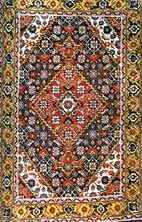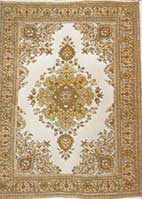The designs and variations in Oriental Rugs are so numerous that it would be impossible to describe them all. These variations in design occur in the two main parts of the rug: The field (or ground and the borders, which frame the interior (the field of the carpet). Designs fall into two different categories: curvilinear and rectilinear.

Rectilinear (Tabriz)

Curvilinear (Tabriz)
Curvilinear designs have floral motifs and patters, with curved outlines and tendrils; rectilinear designs have geometric or angular motifs and patterns. Both of these categories are classified by the type of design or pattern which occupies the field: medallion, repeated motif, all-over, and prayer.
Medallion
The medallion rug will have a field which is dominated by a central medallion or by several medallions. The field surrounding the medallion may be “open” (empty) or semi-open (filled with detached floral sprays or other small motifs).
Repeated Motif
In a repeated design, the central field is filled with multiple rows of the same motif. Among the repeated designs are the Mina Khani, Guli Henna, Herati, Zil-i-soltan, Boteh, and Gul patterns.
MINA KHANI
The Mina Khani design is comprised of repeated floral motifs, each of which is surrounded by four similar smaller flowers, joined in turn by vines to form a diamond arrangement. The design is found in older Bijars, occasionally in Hamadans and Kurds, and quite often in the Veramin.
GULI HENNA
Guli Henna (henna flower) has small yellow plantlike motifs which resemble stalks with many flowers and leaves, and are set in rows; each motif is contained within a diamond-shaped bouquet. This pattern is most often used in older rugs from the Hamadan and the Sultanbad areas.
HERATI
The Herati pattern is the design used most often in the Persian rugs. It consists of a rosette surrounded by four leaves or “fish” and generally, though not necessarily, found inside a diamond shape (“lozenge”) Bijar, Ferahan and Hamadan weave the Herati design with the diamond; Khurasan weaves it without the diamond.
ZIL-I-SOLTAN
The Zil-i-soltan design is made up of multiple rows of repeated mogifs, each of which resembles a vase of roses. This design is found more frequently in Qum and Abadeh; however, it is not restricted to those areas.
BOTEH
The Boteh (paisley) design contains multiple rows of repeated botehs (pine cones or pears). It is probably the most widespread pattern, found in Persian, Caucasian and some Turkoman rugs. Botehs come in different forms and shapes.
GUL
The Gul (Persian for “flower”) is a distinctive recilinear emblem unique to each Turkoman tribe. These multiple identical gulsare arranged in rows.
